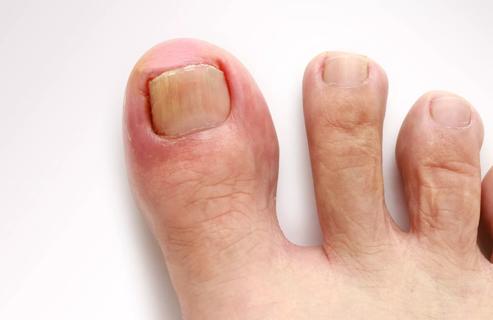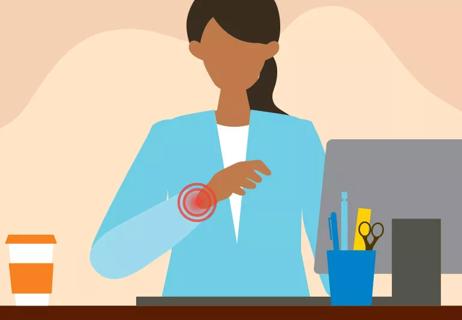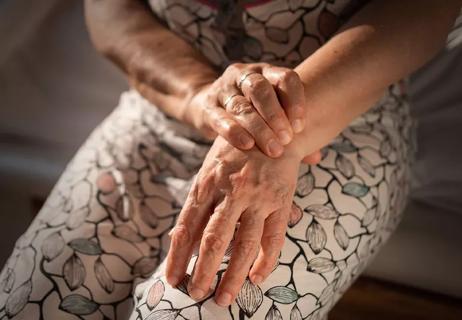A compressed ulnar nerve at the elbow can cause symptoms in your hand

Tingling or numbness in your ring and little fingers? Those are signs you may have cubital tunnel syndrome, also called ulnar nerve entrapment or compression.
Cleveland Clinic is a non-profit academic medical center. Advertising on our site helps support our mission. We do not endorse non-Cleveland Clinic products or services. Policy
The ulnar nerve, commonly called the “funny bone,” runs from the neck down to the hand and provides sensation to the ring and little fingers. It connects to small muscles in the hand that are critical for power grip. This nerve passes through an opening at the elbow called the cubital tunnel.
“Cubital tunnel syndrome is a condition where your ulnar nerve gets progressively compressed (or has too much pressure on it),” says orthopaedic surgeon Peter J. Evans, MD, PhD, who specializes in hand, elbow and shoulder problems. The nerve can become compressed at this region because the tunnel is very narrow, and there is little soft tissue to shelter it.
Ulnar nerve compression may also cause tingling, numbness, burning or aching in the forearm. More severe cases of ulnar nerve compression can cause weakness of grip and difficulty with finger coordination. Severe or long-term compression can lead to muscle wasting, which can’t be reversed.
Don’t confuse cubital tunnel syndrome with the more common nerve entrapment syndrome, carpal tunnel syndrome. The carpal tunnel is in the wrist. “Carpal tunnel syndrome involves the median nerve and affects your thumb, index and long finger,” explains Dr. Evans.
Ulnar nerve compression can occur in people who hold their elbow bent more than 90 degrees for long periods of time. Bending your elbow repeatedly, sleeping with your elbow bent, or prolonged leaning on your elbow can also cause cubital tunnel syndrome.
People who have fractured or dislocated their elbow or who have bone spurs or swelling in the elbow are at increased risk of ulnar nerve compression. “Diabetes is probably the most commonly associated disease,” says Dr. Evans.
Cubital tunnel syndrome can also be caused by joint damage from arthritis. However, cubital tunnel syndrome is a very late occurrence in the course of arthritis, which is uncommon at the elbow.
If you think that you may have cubital tunnel syndrome, see your doctor. Your doctor will perform a physical exam and may order nerve conduction studies to identify where the nerve is being compressed. X-rays may be taken to detect visible causes of compression, such as bone spurs or elbow arthritis.
“Cubital tunnel syndrome is treated by avoiding elbow flexion during activities and while sleeping,” says Dr. Evans. Wearing an elbow splint at night will prevent you from bending your elbow while you’re asleep.
Other things to avoid include resting your elbow on armrests, keeping your elbow bent for extended periods of time, leaning on your elbow, or sitting in a low chair while using a computer. If you talk on the phone a lot, Dr. Evans recommends using a headset instead of holding your phone to your ear.
Early on, nonsteroidal anti-inflammatory drugs, such as ibuprofen (Motrin®, Advil®) or naproxen (Aleve®), may be taken to reduce swelling around the nerve. Surgery is reserved for severe cases in which compression has caused muscle weakness or damage. It is usually performed as an outpatient procedure with generally good results.
Treatment is aimed at preventing progression, which can be functionally devastating. “If treated early, however, cubital tunnel syndrome can be reversed almost fully,” says Dr. Evans.
This article originally appeared in Cleveland Clinic Arthritis Advisor.
Learn more about our editorial process.

Frequent smartphone use can lead to painful issues

Pain meds, toenail protectors and petrolatum jelly may spare you a trip to a podiatrist

An ice bath can ease sore muscles and decrease inflammation after a workout

Wrist flexor and extensor stretches are the best stretches for wrist pain

Simple exercises like tendon glides and finger lifts can have a big impact

They can last 10 to 15 years, but factors like age and activity level can impact their longevity

It’s a normal, common occurrence, but popping with pain or swelling may be a sign of an injury

Safe to wear for most people, compression socks promote better blood circulation in your legs

Your metabolism may torch 1,300 to 2,000 calories daily with no activity

A gentle touch in all the right places may help drain your sinuses